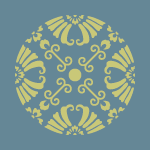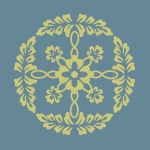|
||
 |
||
1 *mukaimon 向い文.
2 fusenryou 浮線綾 (also called ukiorimono 浮織物 or fusechou-no-maru 臥蝶の丸) which was originally termed ukiori-no-aya 浮織の綾, in description of the floating or over, uki 浮 threads of textiles. Fusenryou came to designate the circular motifs consisting of one central floral motif which radiates out in four directions to often resemble four butterflies.
3 yatsufuji 八ツ藤 (eight wisteria blossoms), also called fuji-no-maru 藤の丸 (wisteria medallion), which consists of a floral center with blossoms radiating out on the axes.
 |
 |
|
| fusenchou 浮線蝶 | yatsufujimaru 八ツ藤丸 |
(C)2001 Japanese Architecture and Art Net Users System. No reproduction or republication without written permission.
掲載のテキスト・写真・イラストなど、全てのコンテンツの無断複製・転載を禁じます。

